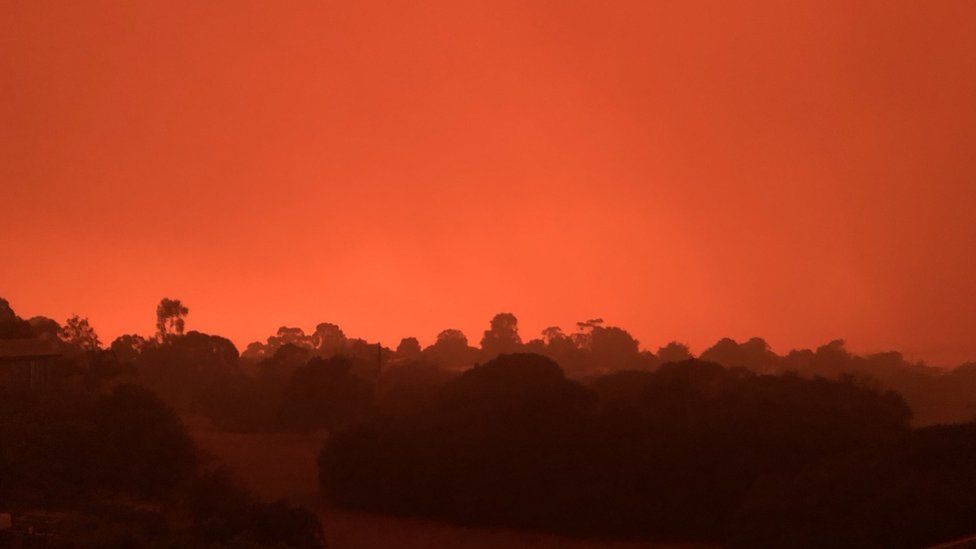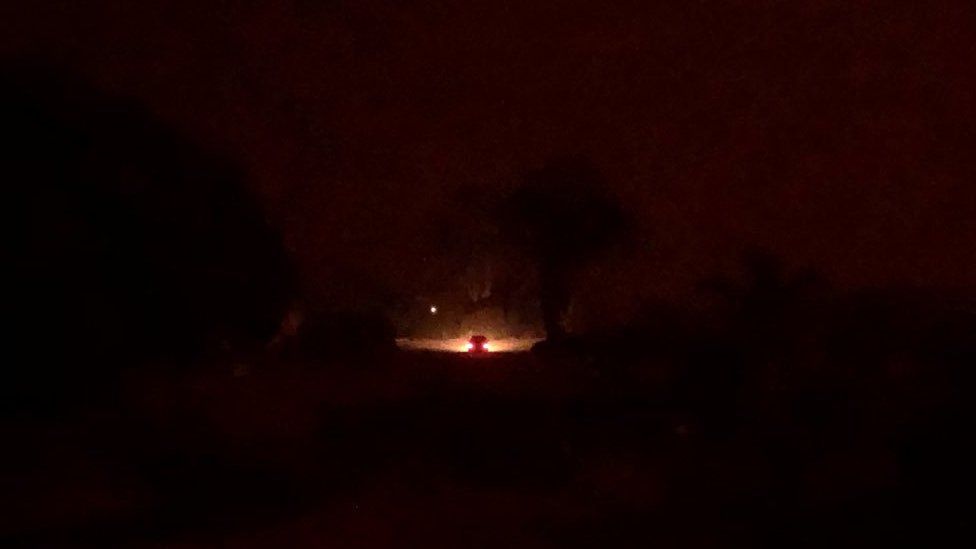Ben Mack

A kangaroo with burnt feet pads rescued from bushfires
in the Blue Mountains. Jill Gralow / Reuters
The bushfires raging in Australia have taken a massive toll on animals — more than a billion of them are thought to have died so far, in what is only the beginning of summer in the Southern Hemisphere.
Fires have burned an estimated 25.5 million acres since September, according to Reuters. The fires have claimed dozens of lives, and destroyed thousands of homes. The fires are so massive, smoke from them has been turning the sky in New Zealand orange — which is about 1,200 miles away. By comparison, the massive Amazon Rainforest fires in 2019 burned an estimated 17.5 million acres.

Massive bushfires are continuing to rage across Australia.The fires have claimed dozens of lives, and destroyed thousands of homes. The smoke is even turning the sky in New Zealand orange — about 1,200 miles away.More than a billion animals are feared to have died so far, and thousands have also been receiving hospital treatment.There are several ways to help — many organizations are taking donations to support rescuers and others affected by the bushfires.Visit Insider's homepage for more stories.
The bushfires raging in Australia have taken a massive toll on animals — more than a billion of them are thought to have died so far, in what is only the beginning of summer in the Southern Hemisphere.
Fires have burned an estimated 25.5 million acres since September, according to Reuters. The fires have claimed dozens of lives, and destroyed thousands of homes. The fires are so massive, smoke from them has been turning the sky in New Zealand orange — which is about 1,200 miles away. By comparison, the massive Amazon Rainforest fires in 2019 burned an estimated 17.5 million acres.

Shayanne Gal/Insider
Celebrities and other well-known figures throughout the world have been calling on the public to join them in helping Australians, while Celeste Barber's Facebook bushfire fundraiser is officially the largest in the platform's history, raising over $28.5 million in just four days.
The fires have had a heartbreaking impact on pets and wild animals too — tens of thousands of koalas are feared dead on Kangaroo Island alone, and last week, the family of late wildlife conservationist Steve Irwin announced that their animal hospital in Queensland had treated more than 90,000 animal patients.
Wildlife Information, Rescue and Education Services (WIRES)
Celebrities and other well-known figures throughout the world have been calling on the public to join them in helping Australians, while Celeste Barber's Facebook bushfire fundraiser is officially the largest in the platform's history, raising over $28.5 million in just four days.
The fires have had a heartbreaking impact on pets and wild animals too — tens of thousands of koalas are feared dead on Kangaroo Island alone, and last week, the family of late wildlife conservationist Steve Irwin announced that their animal hospital in Queensland had treated more than 90,000 animal patients.
Wildlife Information, Rescue and Education Services (WIRES)
volunteer and carer Tracy Burgess holds a severely burnt
brushtail possum rescued from fires near Australia's Blue
Mountains on December 29.


A brushtail possum rescued from fires near Australia's
Blue Mountains. Jill Gralow / Reuters
WIRES volunteer and carer Tracy Dodd holds a kangaroo
WIRES volunteer and carer Tracy Dodd holds a kangaroo
with burnt feet pads after being rescued from bushfires in
the Blue Mountains on December 30.


A kangaroo with burnt feet pads rescued from bushfires
in the Blue Mountains. Jill Gralow / Reuters
A dog visits the burnt-out property of its owner's family
A dog visits the burnt-out property of its owner's family
member in Kia, Australia, on January 8.


A dog in Kia following bushfires. Tracey Nearmy / Reuters
A weary kangaroo shelters on a patch of green grass
A weary kangaroo shelters on a patch of green grass
surrounded by burnt bushland along the Princes Highway
near Milton on January 5.


A kangaroo near in Milton. Tracey Nearmy / Reuters
In this image made from video taken on December 22,
In this image made from video taken on December 22,
and provided by Oakbank Balhannah CFS, a koala drinks
water from a bottle given by a firefighter in Cudlee Creek,
South Australia.


A koala drinking from a water bottle given by a firefighter
in Cudlee Creek. Oakbank Balhannah CFS via AP
A dehydrated and injured Koala receives treatment at the
A dehydrated and injured Koala receives treatment at the
Port Macquarie Koala Hospital in Port Macquarie on November 2.


A dehydrated koala being cared for in Port Macquarie.
SAEED KHAN/AFP via Getty Images
A pet cat sits quietly in its animal carrier at the evacuation
A pet cat sits quietly in its animal carrier at the evacuation
center in the Bomaderry Bowls Club in Bomaderry on January 5.

A pet cat at the evacuation center in the Bomaderry
Bowls Club. Tracey Nearmy / Reuters
Bec Winter stands next to her son, Riley, while hugging her
Bec Winter stands next to her son, Riley, while hugging her
horse Charmer, who she rode to safety through bushfires
on New Year's Eve in Moruya.


Bec Winter, son Riley (right) and horse Charmer.
Jill Gralow / Reuters
Adelaide wildlife rescuer Simon Adamczyk is seen with a
Adelaide wildlife rescuer Simon Adamczyk is seen with a
koala rescued at a burning forest near Cape Borda on
Kangaroo Island.


Simon Adamczyk rescuing a koala near Cape Borda on
Kangaroo Island. AAP Image/David Mariuz/via REUTERS
Animals are seen in Cobargo, as bushfires continue in
Animals are seen in Cobargo, as bushfires continue in
New South Wales, Australia on January 5.


Bushfires near Cobargo in New South Wales.
Tracey Nearmy / Reuters
Giraffes at the Mogo Zoo in Mogo on January 8.

Giraffes at the Mogo Zoo in Mogo on January 8.

Giraffes at the Mogo Zoo. Alkis Konstantinidis / Reuters
An injured koala receives treatment at the Port Macquarie
An injured koala receives treatment at the Port Macquarie
Koala Hospital after its rescue from a bushfire on November 19.


An injured koala at Port Macquarie Koala Hospital.
Tao Shelan/China News Service/VCG via Getty Images
WIRES volunteer and carer Tracy Dodd holds a kangaroo
WIRES volunteer and carer Tracy Dodd holds a kangaroo
with burnt feet pads after it was rescued from bushfires
in the Blue Mountains on December 30.


A kangaroo with burnt feet pads rescued from bushfires
in the Blue Mountains. Jill Gralow / Reuters
A cat sits in a makeshift joey pouch crafted for animals affected by Australia's bushfires, seen in this January 6 image obtained via social media, in Tauranga, New Zealand.

A cat sits in a makeshift joey pouch crafted for animals affected by Australia's bushfires, seen in this January 6 image obtained via social media, in Tauranga, New Zealand.

A cat in a makeshift joey pouch for animals
affected by Australia's bushfires, as seen in
Tauranga, New Zealand. Lara Mackay via Reuters
Chickens mill around a burnt-out property in Kiah on January 8.

Chickens mill around a burnt-out property in Kiah on January 8.

Chickens in Kiah, New South Wales. Tracey Nearmy / Reuters
A Red Heeler dog lies on the ground at the Cobargo evacuation center in Cobargo on January 6.

A Red Heeler dog lies on the ground at the Cobargo evacuation center in Cobargo on January 6.

A Red Heeler dog in Cobargo. Tracey Nearmy / Reuters
Local aboriginal man Anthony Thomas is seen at his uncle's property, destroyed by bushfires, in Kiah on January 8.

Local aboriginal man Anthony Thomas is seen at his uncle's property, destroyed by bushfires, in Kiah on January 8.

Anthony Thomas in Kiah. Tracey Nearmy / Reuters
Read more:Here are 8 ways you can donate money to Australia's bushfire relief effortMore than a billion animals are feared dead in Australia's bushfiresAustralian babies are being born in smoke-filled hospitals as hundreds of bushfires burn across the countryI fled the bushfires in Australia, spent New Year's Eve in an emergency shelter, and photographed the whole thing. Here's what the apocalyptic nightmare looks like on the ground.Surreal photos show smoke from Australia's bushfires turning the sky in New Zealand orange — 1,200 miles away






















